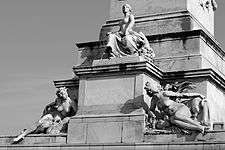Place des Quinconces
The Place des Quinconces, located in Bordeaux, France, is one of the largest city squares in Europe (approximately 31 ac or 12.6 ha).

It was laid out in 1820 on the site of Château Trompette and was intended to prevent rebellion against the city. Its guns were turned towards the centre. Its current shape (lengthened rectangle rounded off with a semicircle) was adopted in 1816. Trees were planted (in quincunxes, hence the name of the square) in 1818.


The two rostral columns (21 m high) facing the Garonne were erected by Henri-Louis Duhamel du Monceau in 1829. One of them symbolises commerce, and the other stands for navigation. The white-marble statues of Michel de Montaigne and Charles de Secondat, baron de Montesquieu (by sculptor Dominique Fortuné Maggesi) were added in 1858.
The principal monument was erected between 1894 and 1902, in memory of the Girondists who fell victim of the Reign of Terror during the French Revolution. It has a large pedestal framed with two basins, decorated with bronze horses and troops, and surmounted by a large column with a statue on top to represent the spirit of liberty.

.jpg)
Among the sculptures are:
- towards the large theatre: triumph of the Republic
- towards Chartrons: triumph of the Concorde
- towards the river: the Tribune with the French cockerel; to its right, History, and on its left, the Éloquence (2 seated people).
- towards the Tourny square: the city of Bordeaux sitting on the prow of a ship with a cornucopia. To the right of the base: the Dordogne River and to the left the Garonne.
At the feet of the tank with horses: Ignorance, Lie and Vice. The quadriga horse-fish is a representation of Happiness. The column was erected by Achille Dumilatre and Victor Rich. The pedestal is by Corgolin. In 1942 the horses that were removed during the German occupation of France in World War II were reerected with their bronze restored.
With the installation of a tram system in 2003, the place has become the most important public transport hub of the area, with two tram lines, 21 bus lines (including 3 night buses), an electric shuttle, and 12 coach lines through Gironde as well as a reception area in the south.
 The column by Dumilatre and Rich
The column by Dumilatre and Rich%2C_2006-07-16.jpg) Statue on top of the column
Statue on top of the column- Sculpture of suffering figures
See also
| Wikimedia Commons has media related to Place des Quinconces. |